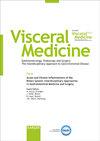Surgical Principles in the Treatment of Ulcerative Colitis
引用次数: 28
Abstract
Background: The primary treatment of ulcerative colitis (UC) is conservative; surgical intervention is carried out in the case of therapy-refractory situation, imminent or malignant transformation, or complications. Surgery for UC should be indicated by interdisciplinary means. Despite the development of drug therapy - in particular the introduction of biologics -, a surgical intervention becomes necessary in a relevant proportion of patients with UC throughout lifetime. Methods: A selective literature search was conducted, taking into account the current studies, reviews, meta-analyses, and guidelines. PubMed served as a database. The present work gives an overview of the surgical options, outcome as well as peri- and postoperative management for patients with UC. Results: Approximately 20% of patients with UC will require surgery during the course of their disease. The rate of colectomy after a disease duration of 10 years is at approximately 16%. Unlike Crohn's disease, UC is principally surgically curable since it is naturally limited to the colon and rectum. Restorative proctocolectomy with an ileal pouch-anal anastomosis represents the surgical treatment of choice. Large studies show a postoperative complication rate of around 30% and a low mortality of 0.1% for this procedure. Chronic pouchitis is one of the main factors limiting the surgical success of curing UC. Despite a high postoperative complication rate, there is a long-term pouch success rate of >90% after 10 and 20 years of follow-up. Conclusion: A close cooperation between the various disciplines in the pre- and postoperative setting is essential for an optimal outcome of patients with UC. Despite a 30% rate of early postoperative complications, normal quality of life can ultimately be reached in more than 90% of patients in experienced centers.溃疡性结肠炎的外科治疗原则
背景:溃疡性结肠炎(UC)的主要治疗方法是保守治疗;手术干预的情况下,治疗难治性的情况下,即将或恶性转化,或并发症。UC的手术应采用跨学科的方法。尽管药物治疗的发展,特别是生物制剂的引入,但在一定比例的UC患者一生中,手术干预是必要的。方法:进行选择性文献检索,考虑当前研究、综述、荟萃分析和指南。PubMed是一个数据库。目前的工作概述了UC患者的手术选择,结果以及围手术期和术后管理。结果:大约20%的UC患者在病程中需要手术。疾病持续10年后结肠切除术的发生率约为16%。与克罗恩病不同,UC主要通过手术治愈,因为它自然局限于结肠和直肠。恢复性直结肠切除术与回肠袋肛管吻合是手术治疗的选择。大型研究表明,该手术的术后并发症发生率约为30%,死亡率低至0.1%。慢性袋炎是限制UC手术治疗成功的主要因素之一。尽管术后并发症发生率高,但经过10年和20年的随访,长期眼袋成功率为90%。结论:在术前和术后各学科之间的密切合作对于UC患者的最佳预后至关重要。尽管有30%的早期术后并发症,但在经验丰富的中心,90%以上的患者最终可以达到正常的生活质量。
本文章由计算机程序翻译,如有差异,请以英文原文为准。
求助全文
约1分钟内获得全文
求助全文

 求助内容:
求助内容: 应助结果提醒方式:
应助结果提醒方式:


